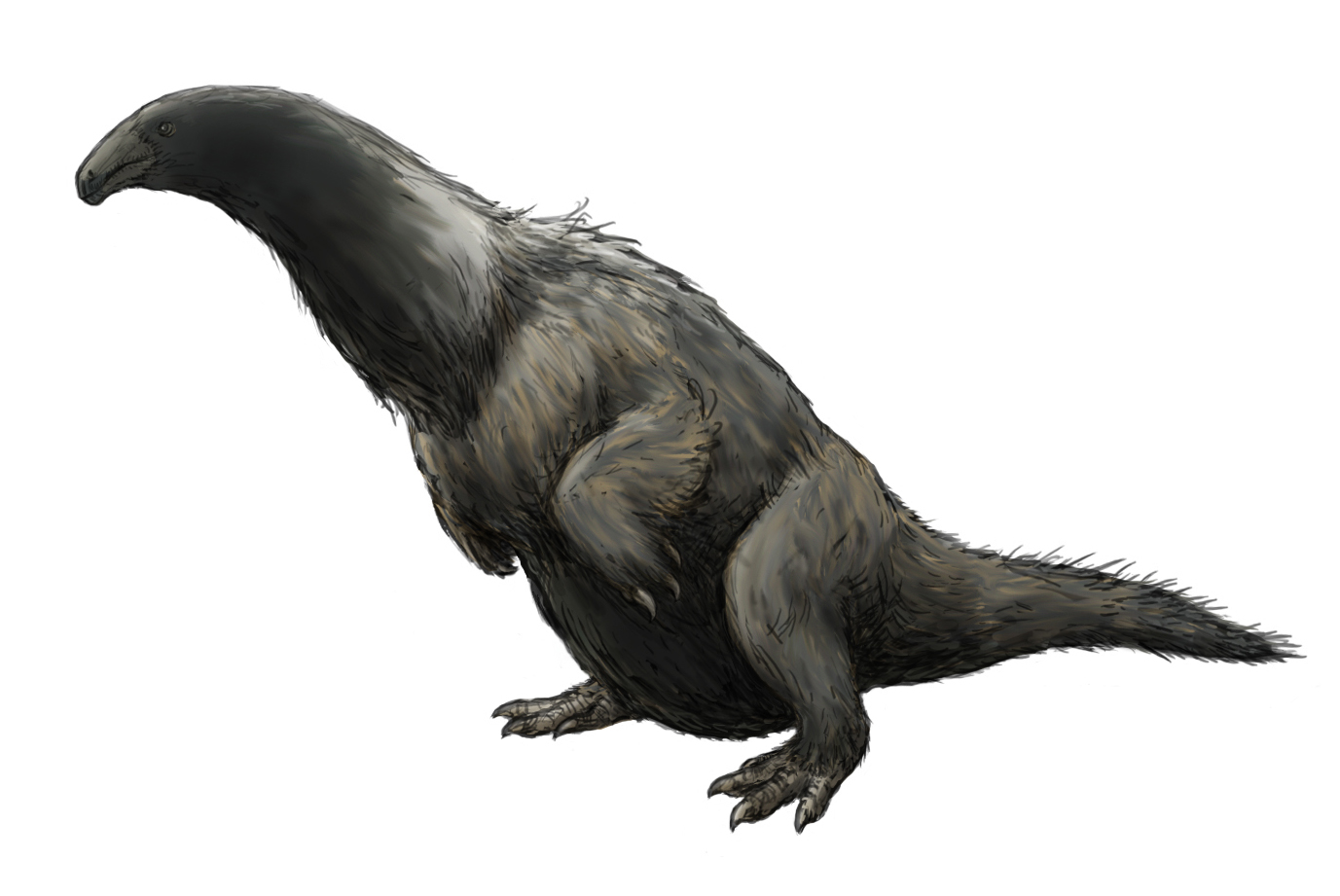Erliansaurus on:
[Wikipedia]
[Google]
[Amazon]
''Erliansaurus'' (meaning "Erlian lizard") is a genus of therizinosaur theropod dinosaur that lived in Asia during the
 The remains of ''Erliansaurus'' were found near Sanhangobi in Inner Mongolia in 1999. The type species, ''Erliansaurus bellamanus'', was described by Xu Xing, Zhang Xiaohong, Paul Sereno, Zhao Xijin, Kuang Xuewen, Han Jun and
The remains of ''Erliansaurus'' were found near Sanhangobi in Inner Mongolia in 1999. The type species, ''Erliansaurus bellamanus'', was described by Xu Xing, Zhang Xiaohong, Paul Sereno, Zhao Xijin, Kuang Xuewen, Han Jun and
 The holotype specimen represents a not fully-grown individual based on one unfused caudal vertebra, and therefore its adult size may be larger than the contemporary '' Neimongosaurus''. It was a small to medium-sized therizinosaur with an estimated length from and a weight of .Genus List for Holtz 2012
The holotype specimen represents a not fully-grown individual based on one unfused caudal vertebra, and therefore its adult size may be larger than the contemporary '' Neimongosaurus''. It was a small to medium-sized therizinosaur with an estimated length from and a weight of .Genus List for Holtz 2012
/ref> ''Erliansaurus'' was a bipedal herbivore. For a therizinosauroid, its cervicals were rather short. The preserved femur was very straight and had a very rounded femoral head; it measures . The tibia was relatively elongated, measuring long. Its fibula had an uncommon form, with a very high front edge and a concave top. The left arm is exceptionally preserved with almost every element intact, its hands bore enormous, strongly recurved and pointed claws of which the thumb claw was the largest, however, the carpal bones are missing.
Cenomanian
The Cenomanian is, in the ICS' geological timescale, the oldest or earliest age of the Late Cretaceous Epoch or the lowest stage of the Upper Cretaceous Series. An age is a unit of geochronology; it is a unit of time; the stage is a unit in the s ...
stage of the Late Cretaceous period in what is now Nei Mongol, Iren Dabasu Formation.
Discovery and naming
 The remains of ''Erliansaurus'' were found near Sanhangobi in Inner Mongolia in 1999. The type species, ''Erliansaurus bellamanus'', was described by Xu Xing, Zhang Xiaohong, Paul Sereno, Zhao Xijin, Kuang Xuewen, Han Jun and
The remains of ''Erliansaurus'' were found near Sanhangobi in Inner Mongolia in 1999. The type species, ''Erliansaurus bellamanus'', was described by Xu Xing, Zhang Xiaohong, Paul Sereno, Zhao Xijin, Kuang Xuewen, Han Jun and Tan Lin
Tan Anthony Lin is an American poet, author, filmmaker, and professor. He defines his work as “ambient" literature, which draws on and samples source material from the Internet and popular culture to address issues involving plagiarism, copyrig ...
in 2002. The generic name refers to the town of Erlian and the specific name Specific name may refer to:
* in Database management systems, a system-assigned name that is unique within a particular database
In taxonomy, either of these two meanings, each with its own set of rules:
* Specific name (botany), the two-part (bino ...
is derived from Latin ''bellus'', "beautiful", and ''manus'', "hand", in reference to the exquisite preservation of the forelimb.
The holotype, LH V0002, was uncovered in the Iren Dabasu Formation dating from the Cenomanian stage. It consists of a partial skeleton belonging to a subadult individual. It includes two cervical, one dorsal and two caudal vertebrae; a right scapula; a left forelimb only lacking the carpus; a partial right ilium and a fragmented ischium and pubis; the right femur; both tibiae, a right fibula and partial metatarsals. No skull traces were found.
Description
 The holotype specimen represents a not fully-grown individual based on one unfused caudal vertebra, and therefore its adult size may be larger than the contemporary '' Neimongosaurus''. It was a small to medium-sized therizinosaur with an estimated length from and a weight of .Genus List for Holtz 2012
The holotype specimen represents a not fully-grown individual based on one unfused caudal vertebra, and therefore its adult size may be larger than the contemporary '' Neimongosaurus''. It was a small to medium-sized therizinosaur with an estimated length from and a weight of .Genus List for Holtz 2012/ref> ''Erliansaurus'' was a bipedal herbivore. For a therizinosauroid, its cervicals were rather short. The preserved femur was very straight and had a very rounded femoral head; it measures . The tibia was relatively elongated, measuring long. Its fibula had an uncommon form, with a very high front edge and a concave top. The left arm is exceptionally preserved with almost every element intact, its hands bore enormous, strongly recurved and pointed claws of which the thumb claw was the largest, however, the carpal bones are missing.
Classification
''Erliansaurus'' was by the describers assigned to the Therizinosauroidea, in a basal position and likely not a therizinosaurid. The cladistic analysis performed by the revision of Zanno in 2010 recovered it as a therizinosauroid. Some early cladistic analyses however, have recovered it as a basal member of the Therizinosauridae. The cladogram below is the result of the recently performed phylogenetic analysis of the Therizinosauridae by Hartman et al.2019
File:2019 collage v1.png, From top left, clockwise: Hong Kong protests turn to widespread riots and civil disobedience; House of Representatives votes to adopt articles of impeachment against Donald Trump; CRISPR gene editing first used to experim ...
.
See also
*Timeline of therizinosaur research
The timeline of therizinosaur research is a chronological listing of events in the history of paleontology focused on therizinosaurs. They were unusually long-necked, pot-bellied, and large-clawed herbivorous theropods most closely related to bir ...
References
{{Taxonbar, from=Q1525258 Late Cretaceous dinosaurs of Asia Fossil taxa described in 2002 Therizinosaurs Taxa named by Xu Xing Taxa named by Paul Sereno